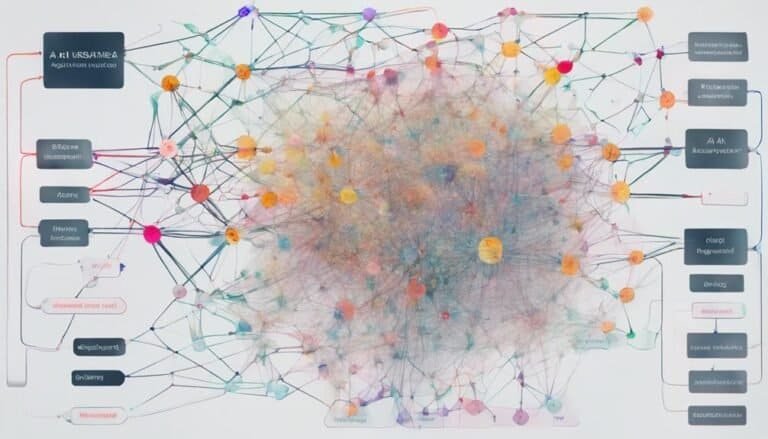Tech for Time Management: AI Time Optimization Tips
|
Getting your Trinity Audio player ready...
|
Did you know that according to a recent study, over 80% of professionals believe that AI could greatly boost productivity in time management tasks?
With the constant demand for efficiency in today's fast-paced world, harnessing the power of AI for time optimization can be a game-changer.
From automating repetitive duties to refining your scheduling process, AI offers a myriad of possibilities to streamline your day.
Ready to reveal the secrets of AI time management?
Key Takeaways
- AI enhances productivity by analyzing work patterns and suggesting workflow improvements.
- Task prioritization optimized with AI, allocating resources efficiently based on deadlines.
- Automation boosts productivity by saving time through task automation and error minimization.
- AI-powered calendar management optimizes daily agenda, suggesting ideal time slots for tasks.
Understanding AI Time Management
To effectively utilize AI in your workflow, understanding AI time management is important for maximizing efficiency and productivity. By incorporating AI productivity tools and time optimization strategies into your daily routine, you can streamline tasks and make the most of your time.
AI productivity tools such as calendar management apps, task automation software, and virtual assistants can help you prioritize tasks, set reminders, and delegate responsibilities more effectively. These tools analyze your work patterns, identify time-consuming tasks, and suggest ways to improve your workflow.
Time optimization strategies like setting specific goals, breaking tasks into smaller steps, and utilizing time-tracking tools can enhance your productivity. By setting clear objectives and deadlines, you can better allocate your time and focus on high-priority tasks.
Understanding how AI can assist you in managing your time efficiently is vital for achieving your goals and maintaining a healthy work-life balance. By embracing AI productivity tools and implementing time optimization strategies, you can enhance your productivity and accomplish more in less time.
Setting Priorities With AI
You can leverage AI to efficiently prioritize tasks by utilizing its analytical capabilities to optimize your workflow and maximize productivity. When it comes to setting priorities with AI, task delegation plays a critical role. AI can analyze the complexity, deadlines, and dependencies of tasks to suggest the most effective order of completion. By delegating tasks based on these insights, you can make sure that your time is allocated where it matters most.
Resource allocation is another key aspect of setting priorities with AI. AI can help you distribute resources such as time, budget, and manpower according to the importance and urgency of tasks. Through data-driven analysis, AI can recommend the best distribution of resources to enhance efficiency and meet deadlines effectively.
Automating Routine Tasks
Automating routine tasks can greatly increase efficiency and streamline workflow processes in various industries. By implementing task automation, you can experience a significant productivity boost and save valuable time.
Here are three key benefits of automating routine tasks:
- Enhanced Productivity: Task automation allows you to focus on high-priority assignments while routine tasks are completed efficiently in the background. This can lead to a substantial increase in productivity as you devote more time to strategic decision-making and creative endeavors.
- Efficiency Enhancement: Automating repetitive tasks eliminates the need for manual intervention, reducing the chances of errors and ensuring consistency in output quality. This efficiency enhancement not only saves time but also enhances overall operational effectiveness.
- Time Saving Solutions: By automating routine tasks, you free up time that can be allocated to more critical activities or personal pursuits. This not only optimizes your workflow but also contributes to a better work-life balance.
AI-Powered Calendar Management
Implementing AI-powered calendar management revolutionizes scheduling efficiency by intelligently optimizing your daily agenda based on priority and availability.
AI scheduling efficiency is achieved through advanced algorithms that analyze your tasks, deadlines, and preferences to suggest the most ideal time slots for each activity.
Calendar optimization techniques employed by AI include considering factors like estimated task duration, travel time, and potential overlaps in appointments to create a seamless schedule.
By leveraging AI in calendar management, you can eliminate the hassle of manually coordinating meetings and appointments, allowing you to focus on high-priority tasks while ensuring a balanced distribution of your time.
These systems can also adapt to changes in real-time, automatically adjusting your schedule when new tasks arise or existing commitments shift.
With AI handling the intricacies of calendar management, you can enhance your productivity and time utilization greatly, making the most out of each day.
Analyzing Time Usage Patterns
By examining your time usage patterns, you can uncover valuable insights into how you allocate your time.
This analysis can reveal areas where you're spending excessive time and identify opportunities for improvement.
Understanding your time usage patterns enables you to optimize your schedule for increased efficiency and productivity.
Time Tracking Benefits
Analyzing time usage patterns can provide valuable insights into how efficiently you're utilizing your time. By tracking your activities, you can identify areas where you may be spending too much time or where you could increase productivity.
Here are three benefits of analyzing time usage patterns:
- Identifying Time Wasters: Pinpoint activities that consume a significant amount of time but contribute little to your productivity.
- Optimizing Workflow: Determine the most efficient sequence of tasks to accomplish more in less time.
- Recognizing Peak Productivity Hours: Discover when you're most focused and energetic to tackle complex tasks, leading to improved efficiency.
Tracking your time usage can lead to significant improvements in productivity and efficiency.
Efficiency Through Analysis
Tracking your activities and analyzing time usage patterns can expose opportunities for enhancing your efficiency and productivity. By delving into your daily routines and identifying where your time is spent, you can pinpoint areas for improvement.
Look for tasks that consume excessive time without significant output, recurring interruptions, or activities that could be delegated or automated. Analyzing these patterns allows you to streamline your workflow, prioritize effectively, and allocate time to tasks that contribute most to your goals.
This method of introspection and adjustment is key to improving productivity and achieving better time optimization. Remember, small changes based on insightful analysis can lead to significant enhancements in how you manage your time and tasks.
Eliminating Time-Wasting Activities
To optimize your time effectively, start by pinpointing activities that consume your time without adding value.
Once you've identified these time stealers, focus on streamlining your daily tasks by automating where possible and eliminating unnecessary steps.
Setting clear priorities will guarantee that you allocate your time to activities that align with your goals and yield the most significant results.
Identify Time Stealers
Identifying and eliminating time stealers is essential for optimizing productivity and efficiency in your daily routine. To enhance your time management skills, consider the following tips:
- Identifying Distractions: Take note of common distractions that consume your time, such as excessive social media use or multitasking. Once identified, work on minimizing their impact by setting boundaries or using tools to block distractions.
- Time Audit Techniques: Conduct a thorough time audit by tracking how you spend each hour of your day. Analyze the results to pinpoint activities that aren't contributing greatly to your goals, and reassess how you allocate your time accordingly.
- Prioritizing Tasks: Focus on high-value tasks that align with your objectives to avoid wasting time on less important activities. By prioritizing effectively, you can make sure that your time is spent on tasks that bring the most value to your work or personal life.
Streamline Daily Tasks
To boost your efficiency and productivity, strategically streamlining your daily tasks is key to eliminating time-wasting activities. Task optimization involves evaluating your current workflow and identifying areas where improvements can be made.
Start by categorizing tasks based on priority and urgency. Utilize tools like task management apps to create to-do lists and set reminders. Consider automating repetitive tasks using AI technology to free up more time for important responsibilities.
Implement workflow enhancement strategies such as setting specific time blocks for different types of tasks and minimizing multitasking. By organizing your daily routine effectively and focusing on essential tasks, you can streamline your workflow and increase overall productivity.
Set Clear Priorities
Evaluate your daily tasks critically, ensuring that every activity aligns with your overall goals and contributes to your productivity. Prioritizing tasks is vital for effective time allocation and achieving best results.
Here are three key strategies to help you eliminate time-wasting activities:
- Importance vs. Urgency: Distinguish between tasks that are important and those that are urgent. Focus on important tasks that align with your goals rather than simply reacting to urgent but less critical matters.
- Delegate or Eliminate: Identify tasks that can be delegated to others or removed from your to-do list entirely to free up time for high-priority activities.
- Time Blocking: Allocate specific time slots for different tasks, ensuring that you dedicate focused time to essential activities while minimizing distractions.
Collaborating With AI Assistants
When collaborating with AI assistants, it's essential to establish clear communication channels and set specific goals to maximize productivity and efficiency. Utilizing AI collaboration strategies can enhance task management by leveraging AI assistants for efficiency and effective delegation.
Begin by defining tasks clearly and allocating them based on each assistant's strengths. Consider integrating AI tools that specialize in different areas, such as scheduling, reminders, or data analysis, to streamline workflows effectively.
Regularly communicate with your AI assistants to provide feedback, adjust priorities, and make certain alignment with overarching objectives.
To maximize productivity, delegate tasks that AI assistants can handle autonomously, freeing up your time for more complex or strategic activities. Set up regular check-ins to review progress, address any issues, and recalibrate strategies if needed.
Enhancing Focus and Concentration
Enhance your ability to concentrate and focus by implementing strategic techniques that optimize your cognitive performance and minimize distractions. In today's fast-paced world, improving productivity and increasing efficiency rely heavily on your capacity to maintain focus amidst various stimuli. Here are three key strategies to help you enhance your focus and concentration:
- Utilize the Pomodoro Technique: Break your work into intervals, typically 25 minutes of focused work followed by a short break. This method can help prevent burnout and enhance your overall concentration levels.
- Create a Distraction-Free Environment: Designate a specific workspace that's free from potential interruptions like noise, clutter, or unrelated devices. By setting up a conducive environment for concentration, you can optimize your ability to stay focused on the task at hand.
- Practice Mindfulness and Meditation: Incorporate mindfulness techniques or short meditation sessions into your routine to enhance your mental clarity and focus. These practices can help train your mind to stay present, reducing distractions and increasing your efficiency in completing tasks.
Conclusion
To sum up, incorporating AI into your time management strategy can truly be a game-changer. By leveraging AI-powered tools to set priorities, automate tasks, and analyze time patterns, you can optimize your productivity like never before.
So, why not let AI be your trusty sidekick in the battle against time? After all, they say time is money, and with AI by your side, you'll be counting the minutes like a savvy investor watching their stocks.







